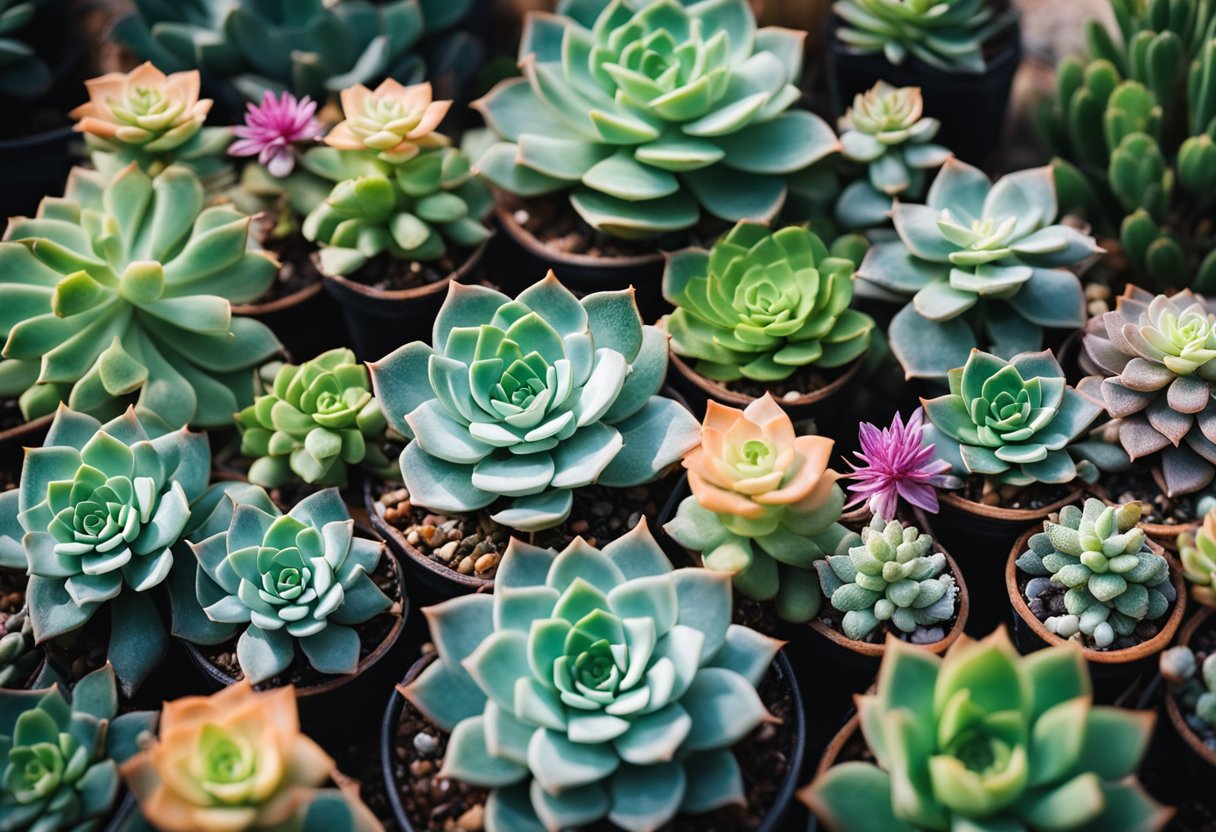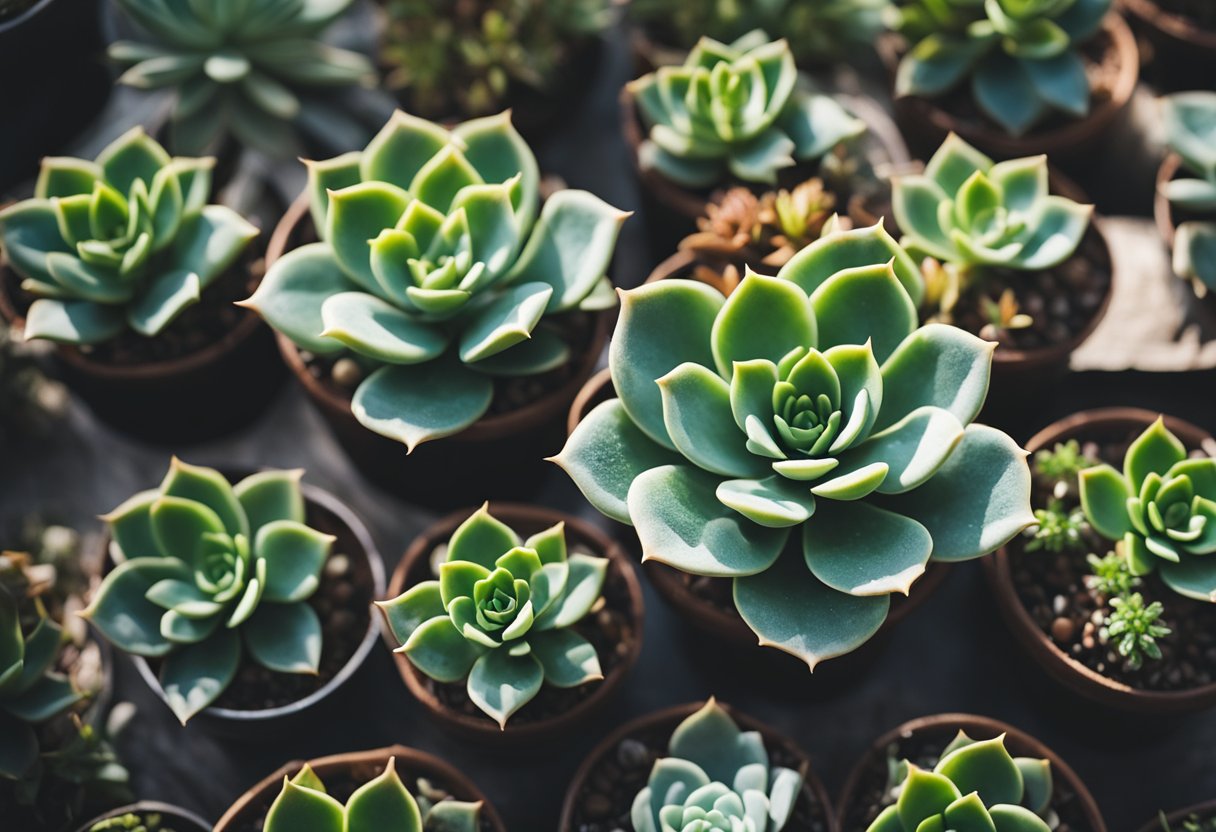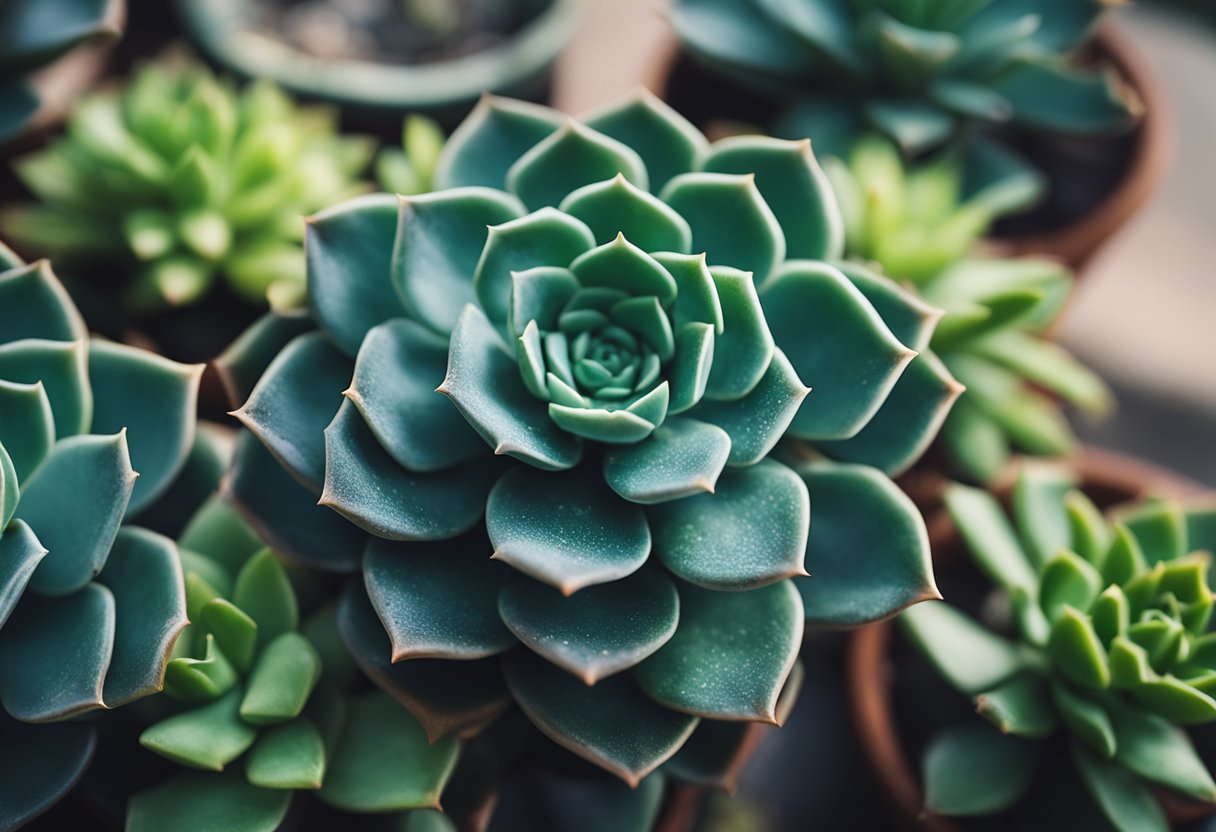Are Succulents Poisonous? A Clear Answer with Expert Knowledge
Succulents are a popular choice for indoor and outdoor gardening due to their low maintenance and aesthetic appeal. However, many people wonder if succulents are poisonous and if they pose a risk to pets or children. The answer is not straightforward, as some succulents can be harmful if ingested, while others are completely safe.
This post may contain affiliate links, which means I’ll receive a commission if you purchase through my link, at no extra cost to you. Please read full disclosure here.

According to the Missouri Poison Center, most succulents are safe to have in the house and can even act as natural humidifiers. However, it’s important to keep them out of reach from children and pets, especially types that have thorns or spines on them that can cause injury to the skin. While most succulents are considered non-toxic and harmless, some have toxicity, which can be a cause for worry. In essence, any plant with spines is deemed to be toxic and should be handled with care.
It’s crucial to know which succulents are poisonous and which are safe to keep in your home. In this article, we will explore the different types of succulents that can be harmful to pets and humans in case of ingestion. We will also provide tips on how to stay safe around succulents and what to do if you suspect someone has been poisoned by a succulent.
Understanding Succulents

Succulents are a type of plant that have adapted to survive in arid environments by storing water in their leaves, stems, and roots. They come in a variety of shapes, sizes, and colors and are often grown as indoor plants due to their low maintenance requirements.
The term “succulent” is used to describe a wide range of plants, including cacti, agaves, and aloes. These plants are all part of the same family, but they differ in appearance and growth habits. Cacti, for example, have spines and are typically found in desert regions, while agaves have large leaves and are often used in landscaping.
While succulents are generally considered safe to grow, it is important to note that some species can be toxic to humans and pets. For example, the sap of certain species of Euphorbia, a genus of succulent, can cause skin irritation and even blindness if it comes into contact with the eyes.
It is important to research the specific species of succulent that you are interested in growing to ensure that it is safe for you and your pets. Some common non-toxic succulents include the jade plant (Crassula ovata), the haworthia plant (Haworthia spp.), and the zebra plant (Haworthia fasciata).
Overall, succulents are a great choice for indoor plants due to their unique appearance and low maintenance requirements. However, it is important to be aware of the potential risks associated with certain species and to take appropriate precautions when handling them.
Common Potentially Poisonous Succulents

Succulents are generally considered to be non-toxic and safe for humans and pets. However, some succulent plants can be harmful if ingested or handled improperly. Here are some of the most common potentially poisonous succulents:
Euphorbia Family
Euphorbia is a large and diverse family of succulent plants that are known for their milky white sap. This sap contains a toxic substance that can cause skin irritation, eye irritation, and even vomiting if ingested. Some of the most popular Euphorbia succulents include Euphorbia milii and Euphorbia trigona.
Kalanchoe Succulents
Kalanchoe succulents are popular houseplants that are known for their colorful flowers and thick leaves. However, these plants contain a toxic substance called cardiac glycosides that can cause heart problems if ingested in large quantities. Some of the most popular Kalanchoe succulents include Kalanchoe blossfeldiana and Kalanchoe tomentosa.
Jade Plant
Jade plant, also known as Crassula ovata, is a popular succulent plant that is often grown as a houseplant. While this plant is generally considered to be non-toxic, it can cause vomiting and diarrhea if ingested in large quantities. It is also important to note that the sap of this plant can cause skin irritation in some people.
Snake Plant
Snake plant, also known as Sansevieria, is a popular succulent plant that is often grown as a houseplant. While this plant is generally considered to be non-toxic, it can cause vomiting and diarrhea if ingested in large quantities. It is also important to note that the sap of this plant can cause skin irritation in some people.
Aloe Vera
Aloe vera is a popular succulent plant that is often used for its medicinal properties. While this plant is generally considered to be safe, it can cause vomiting and diarrhea if ingested in large quantities. It is also important to note that the sap of this plant can cause skin irritation in some people.
Panda Plant
Panda plant, also known as Kalanchoe tomentosa, is a popular succulent plant that is often grown as a houseplant. While this plant is generally considered to be non-toxic, it can cause vomiting and diarrhea if ingested in large quantities. It is also important to note that the sap of this plant can cause skin irritation in some people.
Crown of Thorns
Crown of thorns, also known as Euphorbia milii, is a popular succulent plant that is often grown as a houseplant. While this plant is generally considered to be non-toxic, it can cause skin irritation and eye irritation if the sap comes into contact with the skin or eyes.
It is important to note that this is not an exhaustive list of all potentially poisonous succulent plants. If you are unsure about the toxicity of a specific succulent plant, it is always best to err on the side of caution and keep it out of reach of children and pets.
Symptoms of Succulent Poisoning
Succulents are generally safe to have in the house, but it is important to be aware of the potential symptoms of succulent poisoning. These symptoms can vary depending on the type of succulent and the method of exposure.
Ingestion Symptoms
If a person or pet ingests a poisonous succulent, they may experience symptoms such as vomiting, nausea, diarrhea, stomach upset, stomach pain, abnormal heart rhythm, salivation, lack of coordination, weakness, and seizures. Ingestion of certain succulents, such as Kalanchoe, can cause heart problems if consumed in large quantities.
Skin Contact Symptoms
If a person or pet comes into contact with the sap or juice of a poisonous succulent, they may experience symptoms such as skin irritation, itching, rash, minor skin irritation, and drooling. It is important to note that some succulents, such as Euphorbia, can cause severe skin irritation and even blindness if the sap gets into the eyes.
If you suspect that you or your pet has been exposed to a poisonous succulent, it is important to seek medical attention immediately. Symptoms of succulent poisoning can range from minor skin irritation to life-threatening complications, and prompt treatment is essential for a full recovery.
Safety Measures and Precautions
When handling succulents, it is important to take precautions to avoid any potential harm. While most succulents are not toxic, some can cause skin irritation or allergic reactions. Here are some safety measures to consider:
Handling Succulents
- Wear gloves when handling succulents with thorns or spines to avoid injury.
- Be careful when handling sharp or pointy succulents to avoid puncture wounds.
- Consider wearing eye protection to prevent any debris from getting into your eyes.
- If you have sensitive skin, consider wearing long sleeves and pants to avoid skin irritation.
In Case of Accidental Ingestion
If someone accidentally ingests a succulent, it is important to take immediate action. Here are some steps to follow:
- Call the Poison Help Line or seek medical attention immediately.
- Do not induce vomiting unless instructed to do so by a medical professional.
- Rinse the mouth with lukewarm water.
- Wash the skin with soap and water if the plant was touched.
- Provide as much information as possible to the medical professional, such as the name of the plant and the amount ingested.
Remember, the Poison Control Center is a confidential and free resource that can provide guidance and support in case of accidental ingestion. Pharmacists and nurses are also available to answer any questions and provide medical advice.
Pets and Succulents
Succulents are popular houseplants that are known for their low maintenance and unique shapes. However, pet owners should be aware that some succulent varieties can be toxic to their furry friends. In this section, we will discuss the potential risks of succulents to dogs and cats.
Dogs and Succulents
While most succulents are safe for dogs, there are a few varieties that can cause harm if ingested. Aloe vera, for example, can cause gastrointestinal distress, such as vomiting and diarrhea, and can even make the pet lethargic. Similarly, the jade plant contains a toxin that can cause vomiting, depression, and incoordination in dogs. Other succulent varieties that can be harmful to dogs include the snake plant, kalanchoe, and echeveria.
Pet owners should keep their succulents out of reach of their dogs to prevent any accidental ingestion. If a dog does eat a toxic succulent, it is important to seek veterinary care immediately.
Cats and Succulents
Cats are more sensitive to succulent toxicity than dogs and can experience severe symptoms even with small amounts of ingestion. Some succulent varieties that are toxic to cats include the jade plant, aloe vera, and the string of pearls. Symptoms of succulent poisoning in cats can include vomiting, diarrhea, lethargy, and even seizures.
To prevent any accidental ingestion, pet owners should keep their succulents away from their cats. If a cat does eat a toxic succulent, it is important to seek veterinary care immediately.
In conclusion, while most succulents are safe for pets, there are a few varieties that can be toxic to dogs and cats. Pet owners should be aware of the potential risks and take precautions to keep their pets safe. If a pet does ingest a toxic succulent, it is important to seek veterinary care immediately.
Other Noteworthy Succulents
Succulents are a popular choice for indoor and outdoor gardening due to their low maintenance and unique appearance. While some succulents are poisonous, others are completely harmless. Here are a few noteworthy succulents that are worth considering for your collection:
String of Pearls
String of Pearls (Senecio rowleyanus) is a trailing succulent that is native to South Africa. It is a popular choice for hanging baskets due to its unique appearance – its long, slender stems are lined with small, spherical leaves that resemble pearls. While it is not toxic to humans, it can be harmful to pets if ingested. Symptoms of poisoning include vomiting, diarrhea, and lethargy.
Burro’s Tail
Burro’s Tail (Sedum morganianum) is a trailing succulent that is native to Mexico. Its long, trailing stems are covered in small, plump leaves that resemble beans. While it is not toxic to humans, it can be harmful to pets if ingested. Symptoms of poisoning include vomiting, diarrhea, and lethargy.
Hens and Chicks
Hens and Chicks (Sempervivum) is a popular succulent that is native to Europe and Asia. It is named for its unique growth pattern – the “hen” plant produces small “chick” plants that grow around it. While it is not toxic to humans or pets, it can be harmful if ingested in large quantities.
Overall, while some succulents can be toxic, many are completely harmless. It is important to research the specific needs and toxicity of each succulent before adding it to your collection.
Final Thoughts
In conclusion, while succulents are generally considered safe to have around, it is important to be aware of their potential toxicity. Some succulents contain an unknown substance that can be harmful to humans and animals if ingested. However, many succulents are also known for their healing properties and are used in traditional medicine.
Succulents have a unique defense mechanism that allows them to survive in harsh environments. They are able to store water in their leaves and stems, which makes them resistant to drought. Some succulents also produce steroid compounds that can be mildly toxic to humans and animals.
It is important to note that not all succulents are dangerous. In fact, many common succulents such as aloe vera and jade plants are not considered to be toxic. However, it is always best to err on the side of caution and keep succulents out of reach of children and pets.
If you suspect that your pet has ingested a succulent, it is important to contact a veterinarian immediately. Some succulents can be lethal to pets, especially cats, and it is important to seek medical attention as soon as possible.
Overall, succulents are a great addition to any home or garden. With their unique shapes and colors, they can add a touch of beauty to any space. However, it is important to be aware of their potential toxicity and take precautions to keep them out of reach of children and pets.